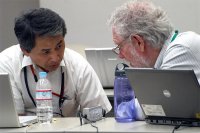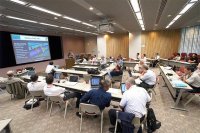 |
 |
|||||||||||||
|
|||||||||||||
|
|||||||||||||
|
Since their appointment in May, the three Global Design Effort Project Managers have been busy scheduling and planning the Engineering Design Report kick-off meetings. Since mid-August they have been touring the world for these meetings. Their purpose is, of course, to kick-start the engineering design phase of the International Linear Collider. During one of these recent meetings, from 10-14 September, the members of the ILC community gathered at KEK to discuss conventional facilities and siting, cryomodules and cryogenics. The primary focus of the EDR kick-off meetings is to consider the planned design and industrialisation effort. The EDR, to be completed in 2010, will contain an updated ILC value estimate and a project execution plan, based on an assessment of the Reference Design Report technical content and its value estimate. To achieve these goals, meetings began with reviewing the design proposed in the reference design to eventually define and clearly document performance-driven specifications for the accelerator components. “It is much more tough work than it seems,” says KEK's Akira Yamamoto, one of the project managers. “Communication is the most difficult factor,” says Marc Ross of Fermilab, another project manager who attended the KEK meeting. Many of the meeting attendees have mostly regional responsibilities. “We are trying to optimise their already existing plan. It is tough for us and also for them,” says Ross. The position of each country is different not only from the technical point of view, but also from those relating to safety regulations. Identifying and sharing information in each region with all scientists and engineers will be a key to success for the ILC community, which has the characteristics of a 'grassroots' organisation, not having a strong institutional centre like CERN or ITER, at least during the EDR phase. If there was one centralised institution it would be easier to establish a unified design to pursue the technical and scientific goals. The ILC, as a true international project, will require a balanced global collaboration, and competition will be the most significant issue. On the other hand, the ILC project is responsible to show each of the regions, countries, institutions and tax payers how the ILC will benefit our society. “Nobody will be satisfied just contributing to the budget for something only because of an international decision. We need to keep the international cooperation with keeping healthy competitions in science and technology because they respond to each country's intellectual interest, and I hope the ILC can eventually provide benefits for each country scientifically and have a cultural influence,” says Yamamoto. The unification of the base-line design is important. On the other hand, it is also very important to encourage the scientist' motivation for technical advances. It may result in the wisest ILC design and performance with intellectual feed back to our society. The project managers are also reviewing the cost estimate, checking the inconsistencies in numerology and unit prices, identifying cost items that are 'questionable', and critically reviewing each design decision with regard to its cost impact. They also need to define the work packages. “We still have a long, long way to go”, say Ross and Yamamoto together. “We are very much enjoying working together, but we do argue a lot sometimes,” says Yamamoto. These in-depth exchanges of opinion, however, are definitely needed to move forward down the road of the EDR phase. “These kick-off meetings have accomplished a certain measure of success for the step toward the next big meeting at Fermilab this October,” says Yamamoto. -- Rika Takahashi |
|||||||||||||
| © International Linear Collider |

